2012 NISSAN CUBE seat adjustment
[x] Cancel search: seat adjustmentPage 40 of 331
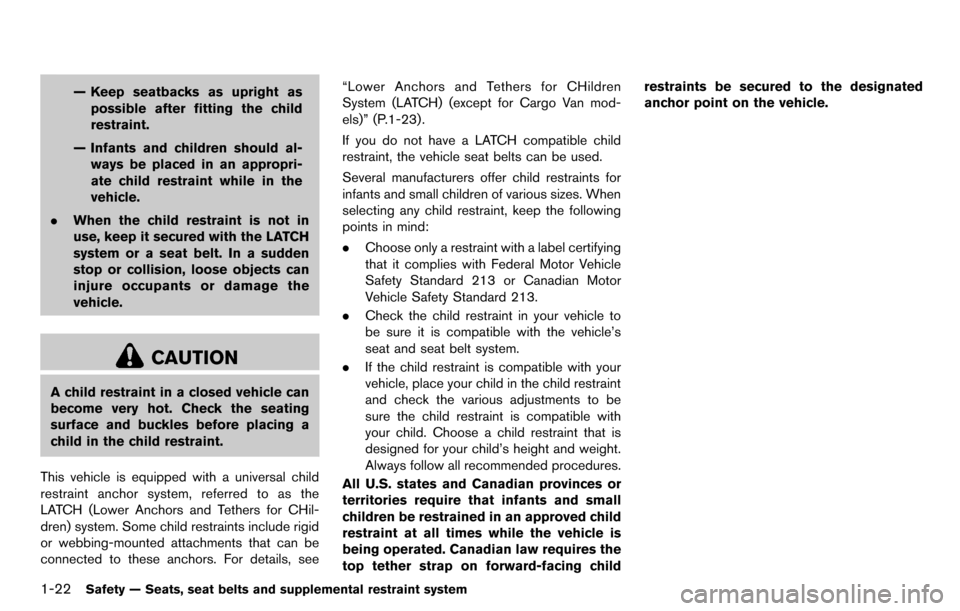
1-22Safety — Seats, seat belts and supplemental restraint system
— Keep seatbacks as upright aspossible after fitting the child
restraint.
— Infants and children should al- ways be placed in an appropri-
ate child restraint while in the
vehicle.
. When the child restraint is not in
use, keep it secured with the LATCH
system or a seat belt. In a sudden
stop or collision, loose objects can
injure occupants or damage the
vehicle.
CAUTION
A child restraint in a closed vehicle can
become very hot. Check the seating
surface and buckles before placing a
child in the child restraint.
This vehicle is equipped with a universal child
restraint anchor system, referred to as the
LATCH (Lower Anchors and Tethers for CHil-
dren) system. Some child restraints include rigid
or webbing-mounted attachments that can be
connected to these anchors. For details, see “Lower Anchors and Tethers for CHildren
System (LATCH) (except for Cargo Van mod-
els)” (P.1-23).
If you do not have a LATCH compatible child
restraint, the vehicle seat belts can be used.
Several manufacturers offer child restraints for
infants and small children of various sizes. When
selecting any child restraint, keep the following
points in mind:
.
Choose only a restraint with a label certifying
that it complies with Federal Motor Vehicle
Safety Standard 213 or Canadian Motor
Vehicle Safety Standard 213.
. Check the child restraint in your vehicle to
be sure it is compatible with the vehicle’s
seat and seat belt system.
. If the child restraint is compatible with your
vehicle, place your child in the child restraint
and check the various adjustments to be
sure the child restraint is compatible with
your child. Choose a child restraint that is
designed for your child’s height and weight.
Always follow all recommended procedures.
All U.S. states and Canadian provinces or
territories require that infants and small
children be restrained in an approved child
restraint at all times while the vehicle is
being operated. Canadian law requires the
top tether strap on forward-facing child restraints be secured to the designated
anchor point on the vehicle.
Page 50 of 331
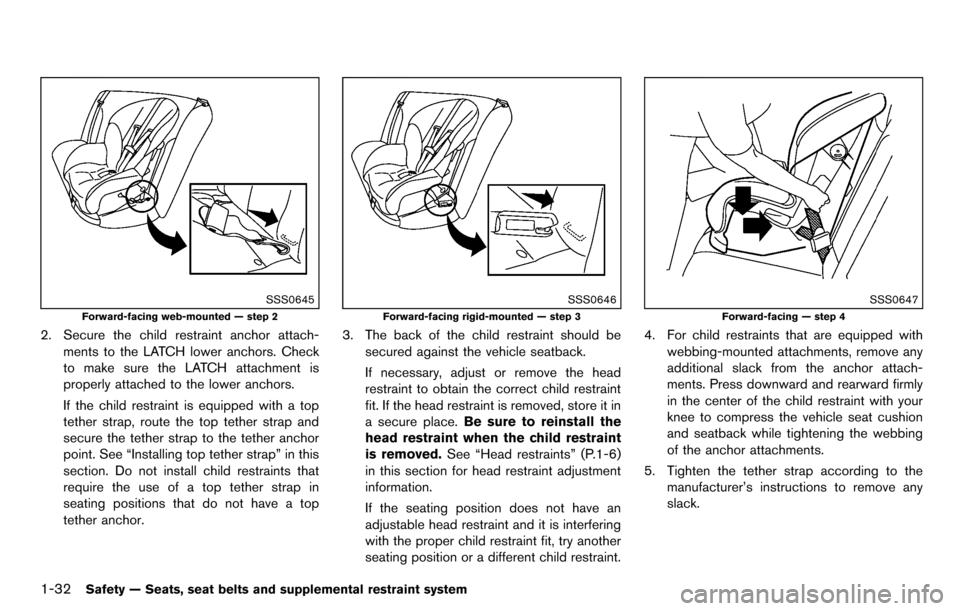
1-32Safety — Seats, seat belts and supplemental restraint system
SSS0645
Forward-facing web-mounted — step 2
2. Secure the child restraint anchor attach-ments to the LATCH lower anchors. Check
to make sure the LATCH attachment is
properly attached to the lower anchors.
If the child restraint is equipped with a top
tether strap, route the top tether strap and
secure the tether strap to the tether anchor
point. See “Installing top tether strap” in this
section. Do not install child restraints that
require the use of a top tether strap in
seating positions that do not have a top
tether anchor.
SSS0646
Forward-facing rigid-mounted — step 3
3. The back of the child restraint should besecured against the vehicle seatback.
If necessary, adjust or remove the head
restraint to obtain the correct child restraint
fit. If the head restraint is removed, store it in
a secure place. Be sure to reinstall the
head restraint when the child restraint
is removed. See “Head restraints” (P.1-6)
in this section for head restraint adjustment
information.
If the seating position does not have an
adjustable head restraint and it is interfering
with the proper child restraint fit, try another
seating position or a different child restraint.
SSS0647
Forward-facing — step 4
4. For child restraints that are equipped with webbing-mounted attachments, remove any
additional slack from the anchor attach-
ments. Press downward and rearward firmly
in the center of the child restraint with your
knee to compress the vehicle seat cushion
and seatback while tightening the webbing
of the anchor attachments.
5. Tighten the tether strap according to the manufacturer’s instructions to remove any
slack.
Page 52 of 331
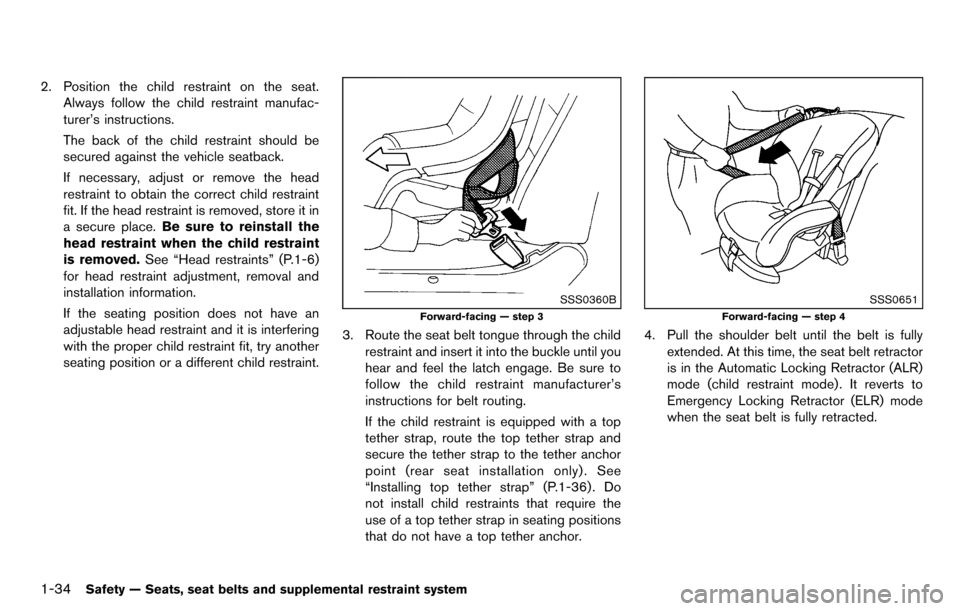
1-34Safety — Seats, seat belts and supplemental restraint system
2. Position the child restraint on the seat.Always follow the child restraint manufac-
turer’s instructions.
The back of the child restraint should be
secured against the vehicle seatback.
If necessary, adjust or remove the head
restraint to obtain the correct child restraint
fit. If the head restraint is removed, store it in
a secure place. Be sure to reinstall the
head restraint when the child restraint
is removed. See “Head restraints” (P.1-6)
for head restraint adjustment, removal and
installation information.
If the seating position does not have an
adjustable head restraint and it is interfering
with the proper child restraint fit, try another
seating position or a different child restraint.
SSS0360B
Forward-facing — step 3
3. Route the seat belt tongue through the child restraint and insert it into the buckle until you
hear and feel the latch engage. Be sure to
follow the child restraint manufacturer’s
instructions for belt routing.
If the child restraint is equipped with a top
tether strap, route the top tether strap and
secure the tether strap to the tether anchor
point (rear seat installation only) . See
“Installing top tether strap” (P.1-36) . Do
not install child restraints that require the
use of a top tether strap in seating positions
that do not have a top tether anchor.
SSS0651
Forward-facing — step 4
4. Pull the shoulder belt until the belt is fullyextended. At this time, the seat belt retractor
is in the Automatic Locking Retractor (ALR)
mode (child restraint mode) . It reverts to
Emergency Locking Retractor (ELR) mode
when the seat belt is fully retracted.
Page 55 of 331
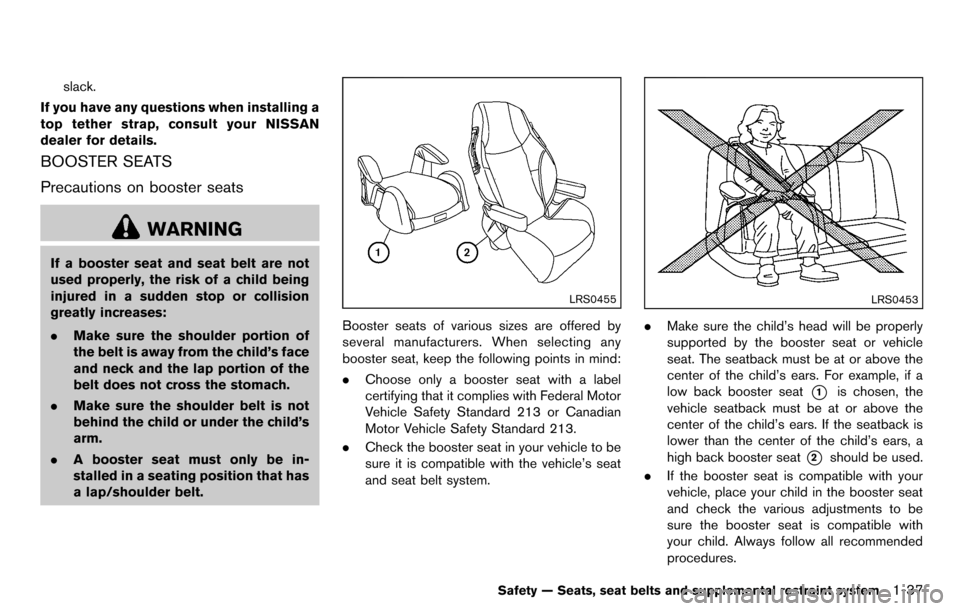
slack.
If you have any questions when installing a
top tether strap, consult your NISSAN
dealer for details.
BOOSTER SEATS
Precautions on booster seats
WARNING
If a booster seat and seat belt are not
used properly, the risk of a child being
injured in a sudden stop or collision
greatly increases:
. Make sure the shoulder portion of
the belt is away from the child’s face
and neck and the lap portion of the
belt does not cross the stomach.
. Make sure the shoulder belt is not
behind the child or under the child’s
arm.
. A booster seat must only be in-
stalled in a seating position that has
a lap/shoulder belt.
LRS0455
Booster seats of various sizes are offered by
several manufacturers. When selecting any
booster seat, keep the following points in mind:
.Choose only a booster seat with a label
certifying that it complies with Federal Motor
Vehicle Safety Standard 213 or Canadian
Motor Vehicle Safety Standard 213.
. Check the booster seat in your vehicle to be
sure it is compatible with the vehicle’s seat
and seat belt system.
LRS0453
.Make sure the child’s head will be properly
supported by the booster seat or vehicle
seat. The seatback must be at or above the
center of the child’s ears. For example, if a
low back booster seat
*1is chosen, the
vehicle seatback must be at or above the
center of the child’s ears. If the seatback is
lower than the center of the child’s ears, a
high back booster seat
*2should be used.
. If the booster seat is compatible with your
vehicle, place your child in the booster seat
and check the various adjustments to be
sure the booster seat is compatible with
your child. Always follow all recommended
procedures.
Safety — Seats, seat belts and supplemental restraint system1-37
Page 57 of 331

LRS0454
Front passenger position
3. The booster seat should be positioned onthe vehicle seat so that it is stable.
If necessary, adjust or remove the head
restraint to obtain the correct booster seat
fit. If the head restraint is removed, store it in
a secure place. Be sure to reinstall the
head restraint when the booster seat is
removed. See “Head restraints” (P.1-6) for
head restraint adjustment, removal and
installation information.
If the seating position does not have an
adjustable head restraint and it is interfering
with the proper booster seat fit, try another
seating position or a different booster seat. 4. Position the lap portion of the seat belt low
and snug on the child’s hips. Be sure to
follow the booster seat manufacturer’s
instructions for adjusting the seat belt
routing.
5. Pull the shoulder belt portion of the seat belt toward the retractor to take up extra slack.
Be sure the shoulder belt is positioned
across the top, middle portion of the child’s
shoulder. Be sure to follow the booster seat
manufacturer’s instructions for adjusting the
seat belt routing.
6. Follow the warnings, cautions and instruc- tions for properly fastening a seat belt
shown in “Seat belts” (P.1-10) .
SSS0481
7. If the booster seat is installed in the front
passenger seat, place the ignition switch in
the ON position. The front passenger air bag
status light
may or may not be
illuminated depending on the size of the
child and the type of booster seat used.
(See “Front passenger air bag and status
light” (P.1-47).)
Safety — Seats, seat belts and supplemental restraint system1-39
Page 116 of 331
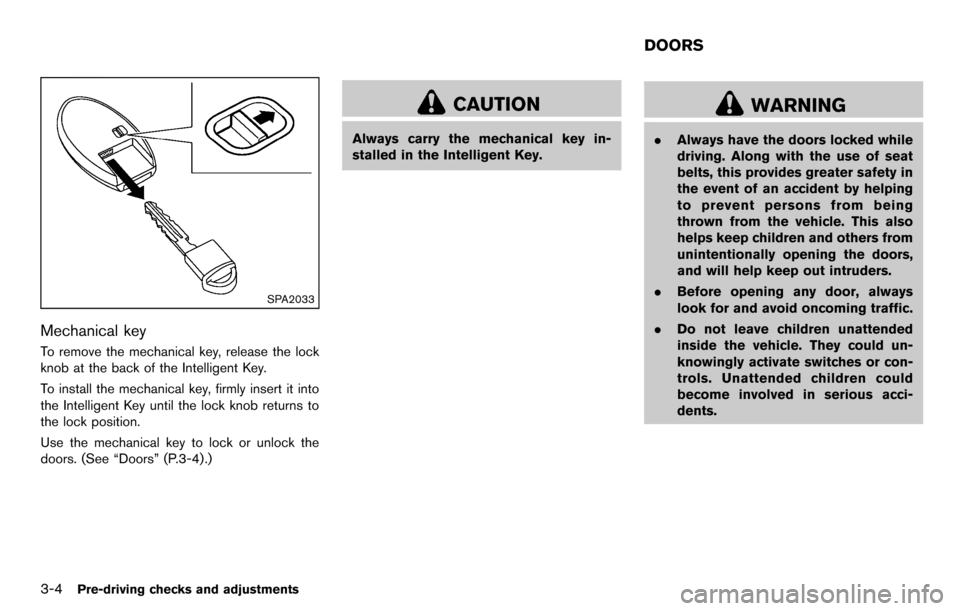
3-4Pre-driving checks and adjustments
SPA2033
Mechanical key
To remove the mechanical key, release the lock
knob at the back of the Intelligent Key.
To install the mechanical key, firmly insert it into
the Intelligent Key until the lock knob returns to
the lock position.
Use the mechanical key to lock or unlock the
doors. (See “Doors” (P.3-4).)
CAUTION
Always carry the mechanical key in-
stalled in the Intelligent Key.
WARNING
.Always have the doors locked while
driving. Along with the use of seat
belts, this provides greater safety in
the event of an accident by helping
to prevent persons from being
thrown from the vehicle. This also
helps keep children and others from
unintentionally opening the doors,
and will help keep out intruders.
. Before opening any door, always
look for and avoid oncoming traffic.
. Do not leave children unattended
inside the vehicle. They could un-
knowingly activate switches or con-
trols. Unattended children could
become involved in serious acci-
dents.
DOORS
Page 324 of 331
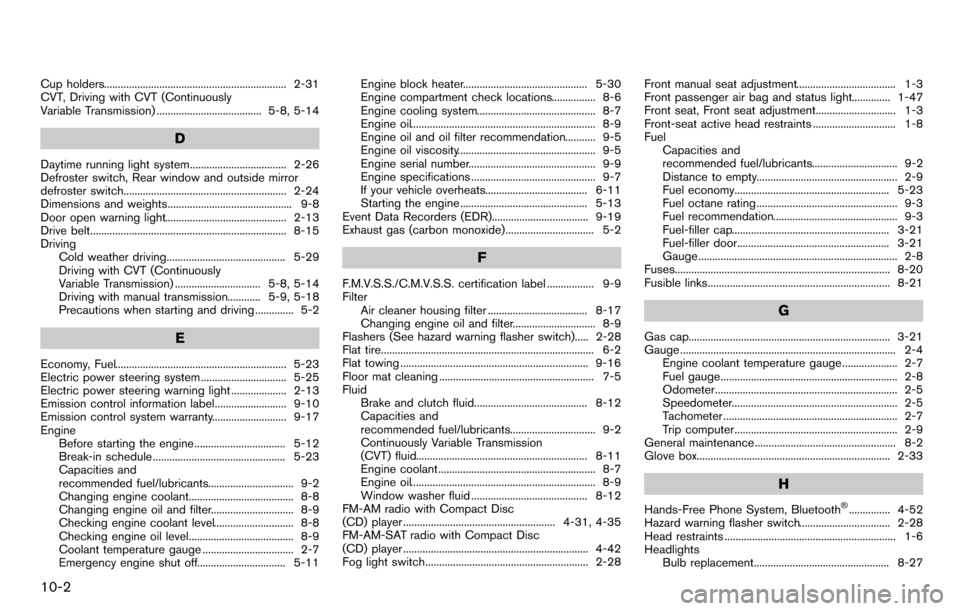
10-2
Cup holders.................................................................. 2-31
CVT, Driving with CVT (Continuously
Variable Transmission) ...................................... 5-8, 5-14
D
Daytime running light system................................... 2-26
Defroster switch, Rear window and outside mirror
defroster switch........................................................... 2-24
Dimensions and weights............................................. 9-8
Door open warning light............................................ 2-13
Drive belt....................................................................... 8-15
Driving Cold weather driving........................................... 5-29
Driving with CVT (Continuously
Variable Transmission) ............................... 5-8, 5-14
Driving with manual transmission............ 5-9, 5-18
Precautions when starting and driving .............. 5-2
E
Economy, Fuel.............................................................. 5-23
Electric power steering system ............................... 5-25
Electric power steering warning light .................... 2-13
Emission control information label.......................... 9-10
Emission control system warranty........................... 9-17
Engine Before starting the engine................................. 5-12
Break-in schedule ................................................ 5-23
Capacities and
recommended fuel/lubricants............................... 9-2
Changing engine coolant...................................... 8-8
Changing engine oil and filter.............................. 8-9
Checking engine coolant level............................. 8-8
Checking engine oil level...................................... 8-9
Coolant temperature gauge ................................. 2-7
Emergency engine shut off................................ 5-11 Engine block heater............................................. 5-30
Engine compartment check locations................ 8-6
Engine cooling system........................................... 8-7
Engine oil................................................................... 8-9
Engine oil and oil filter recommendation........... 9-5
Engine oil viscosity.................................................. 9-5
Engine serial number.............................................. 9-9
Engine specifications ............................................. 9-7
If your vehicle overheats..................................... 6-11
Starting the engine .............................................. 5-13
Event Data Recorders (EDR)................................... 9-19
Exhaust gas (carbon monoxide)................................ 5-2
F
F.M.V.S.S./C.M.V.S.S. certification label ................. 9-9
Filter Air cleaner housing filter .................................... 8-17
Changing engine oil and filter.............................. 8-9
Flashers (See hazard warning flasher switch)..... 2-28
Flat tire............................................................................. 6-2
Flat towing .................................................................... 9-16
Floor mat cleaning ........................................................ 7-5
Fluid Brake and clutch fluid......................................... 8-12
Capacities and
recommended fuel/lubricants............................... 9-2
Continuously Variable Transmission
(CVT) fluid.............................................................. 8-11
Engine coolant......................................................... 8-7
Engine oil................................................................... 8-9
Window washer fluid .......................................... 8-12
FM-AM radio with Compact Disc
(CD) player ....................................................... 4-31, 4-35
FM-AM-SAT radio with Compact Disc
(CD) player ................................................................... 4-42
Fog light switch........................................................... 2-28 Front manual seat adjustment.................................... 1-3
Front passenger air bag and status light.............. 1-47
Front seat, Front seat adjustment............................. 1-3
Front-seat active head restraints .............................. 1-8
Fuel Capacities and
recommended fuel/lubricants............................... 9-2
Distance to empty................................................... 2-9
Fuel economy........................................................ 5-23
Fuel octane rating ................................................... 9-3
Fuel recommendation............................................. 9-3
Fuel-filler cap......................................................... 3-21
Fuel-filler door....................................................... 3-21
Gauge ........................................................................ 2-8
Fuses.............................................................................. 8-20
Fusible links.................................................................. 8-21
G
Gas cap......................................................................... 3-21
Gauge .............................................................................. 2-4 Engine coolant temperature gauge .................... 2-7
Fuel gauge................................................................ 2-8
Odometer.................................................................. 2-5
Speedometer............................................................ 2-5
Tachometer ............................................................... 2-7
Trip computer........................................................... 2-9
General maintenance ................................................... 8-2
Glove box...................................................................... 2-33
H
Hands-Free Phone System, Bluetooth®............... 4-52
Hazard warning flasher switch................................. 2-28
Head restraints .............................................................. 1-6
Headlights Bulb replacement................................................. 8-27
Page 325 of 331
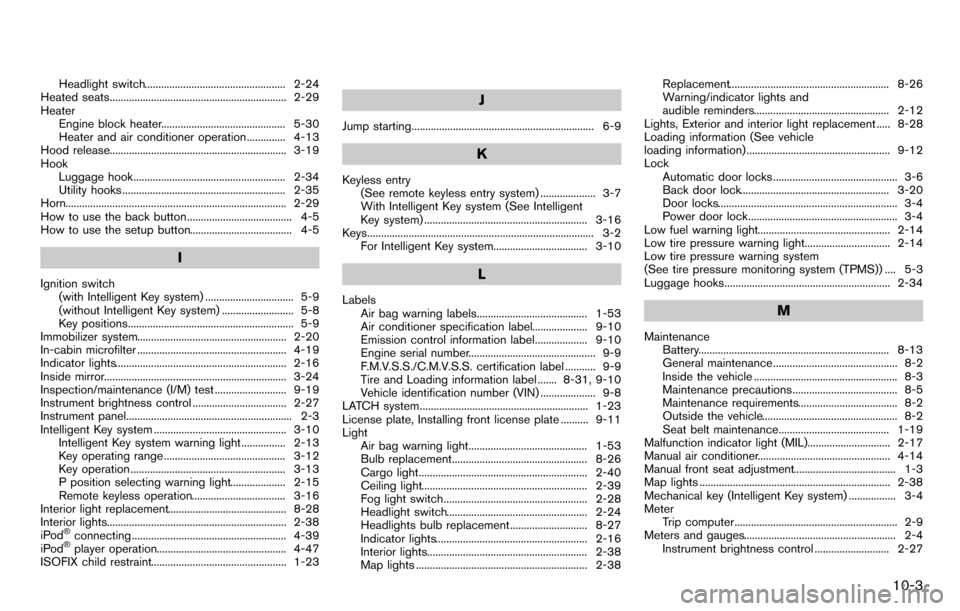
Headlight switch................................................... 2-24
Heated seats................................................................ 2-29
Heater Engine block heater............................................. 5-30
Heater and air conditioner operation.............. 4-13
Hood release................................................................ 3-19
Hook Luggage hook....................................................... 2-34
Utility hooks ........................................................... 2-35
Horn................................................................................ 2-29
How to use the back button...................................... 4-5
How to use the setup button..................................... 4-5
I
Ignition switch (with Intelligent Key system) ................................ 5-9
(without Intelligent Key system) .......................... 5-8
Key positions............................................................ 5-9
Immobilizer system...................................................... 2-20
In-cabin microfilter ...................................................... 4-19
Indicator lights.............................................................. 2-16
Inside mirror.................................................................. 3-24
Inspection/maintenance (I/M) test .......................... 9-19
Instrument brightness control .................................. 2-27
Instrument panel............................................................ 2-3
Intelligent Key system ................................................ 3-10 Intelligent Key system warning light................ 2-13
Key operating range ............................................ 3-12
Key operation ........................................................ 3-13
P position selecting warning light.................... 2-15
Remote keyless operation.................................. 3-16
Interior light replacement........................................... 8-28
Interior lights................................................................. 2-38
iPod
®connecting........................................................ 4-39
iPod®player operation............................................... 4-47
ISOFIX child restraint................................................. 1-23
J
Jump starting.................................................................. 6-9
K
Keyless entry (See remote keyless entry system) .................... 3-7
With Intelligent Key system (See Intelligent
Key system) ........................................................... 3-16
Keys.................................................................................. 3-2 For Intelligent Key system.................................. 3-10
L
LabelsAir bag warning labels........................................ 1-53
Air conditioner specification label.................... 9-10
Emission control information label................... 9-10
Engine serial number.............................................. 9-9
F.M.V.S.S./C.M.V.S.S. certification label ........... 9-9
Tire and Loading information label ....... 8-31, 9-10
Vehicle identification number (VIN) .................... 9-8
LATCH system............................................................. 1-23
License plate, Installing front license plate .......... 9-11
Light Air bag warning light........................................... 1-53
Bulb replacement................................................. 8-26
Cargo light............................................................. 2-40
Ceiling light............................................................ 2-39
Fog light switch.................................................... 2-28
Headlight switch................................................... 2-24
Headlights bulb replacement............................ 8-27
Indicator lights....................................................... 2-16
Interior lights.......................................................... 2-38
Map lights .............................................................. 2-38 Replacement.......................................................... 8-26
Warning/indicator lights and
audible reminders................................................. 2-12
Lights, Exterior and interior light replacement ..... 8-28
Loading information (See vehicle
loading information) .................................................... 9-12
Lock Automatic door locks ............................................. 3-6
Back door lock...................................................... 3-20
Door locks................................................................. 3-4
Power door lock...................................................... 3-4
Low fuel warning light................................................ 2-14
Low tire pressure warning light............................... 2-14
Low tire pressure warning system
(See tire pressure monitoring system (TPMS)) .... 5-3
Luggage hooks............................................................ 2-34M
Maintenance Battery..................................................................... 8-13
General maintenance ............................................. 8-2
Inside the vehicle .................................................... 8-3
Maintenance precautions...................................... 8-5
Maintenance requirements.................................... 8-2
Outside the vehicle................................................. 8-2
Seat belt maintenance........................................ 1-19
Malfunction indicator light (MIL).............................. 2-17
Manual air conditioner................................................ 4-14
Manual front seat adjustment..................................... 1-3
Map lights ..................................................................... 2-38
Mechanical key (Intelligent Key system) ................. 3-4
Meter Trip computer........................................................... 2-9
Meters and gauges....................................................... 2-4 Instrument brightness control ........................... 2-27
10-3